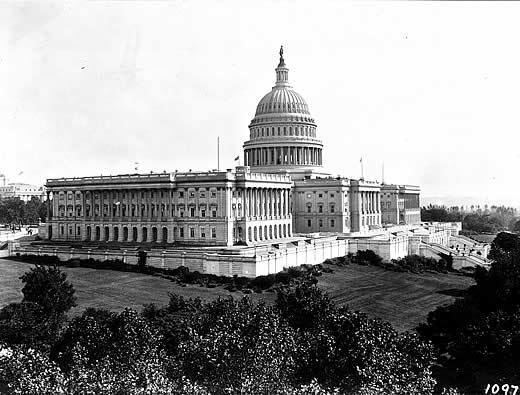Senate President Levi P. Morton (R) House Speaker Thomas B. Reed (R) House Majority Republican | Senate Pres. pro tem John J. Ingalls (R) Senate Majority Republican | |
 | ||
Members 88 Senators
332 Representatives
9 Non-voting members | ||
The Fifty-first United States Congress, referred to by some critics as the Billion Dollar Congress, was a meeting of the legislative branch of the United States federal government, consisting of the United States Senate and the United States House of Representatives. It met in Washington, D.C., from March 4, 1889, to March 4, 1891, during the first two years of the administration of U.S. President Benjamin Harrison.
Contents
- Major events
- Major legislation
- States admitted and territories organized
- Party summary
- Senate
- House of Representatives
- Members
- Changes in membership
- Committees
- Joint committees
- Employees
- References
The apportionment of seats in this House of Representatives was based on the Tenth Census of the United States in 1880. Both chambers had a Republican majority. This marked the first time since the 43rd United States Congress that both chambers were controlled by the president's party.
Major events
Major legislation
It was responsible for a number of pieces of landmark legislation, many of which asserted the authority of the federal government.
Emboldened by their success in the elections of 1888, the Republicans enacted virtually their entire platform during their first 303-day session, including a measure that provided American Civil War veterans with generous pensions and expanded the list of eligible recipients to include noncombatants and the children of veterans. Grover Cleveland had vetoed a similar bill in 1887. It was criticized as the "Billion Dollar Congress'" for its lavish spending and, for this reason it incited drastic reversals in public support that led to Cleveland's reelection in 1892.
Other important legislation passed into law by the Congress included the McKinley tariff, authored by Representative, and future President, William McKinley; the Sherman Antitrust Act, which prohibited business combinations that restricted trade; and the Sherman Silver Purchase Act, which required the U.S. government to mint silver. The last two were concessions to Western farmer interests in exchange for support of the tariff and would become central tenets of the Populist Party later in the decade. They were authored by Senator John Sherman.
The Fifty-first Congress was also responsible for passing the Land Revision Act of 1891, which created the national forests. Harrison authorized America's first forest reserve in Yellowstone, Wyoming, the same year.
Other bills were discussed but failed to pass, including two significant pieces of legislation focused on ensuring African Americans the right to vote. Henry Cabot Lodge sponsored a so-called Lodge Bill that would have established federal supervision of Congressional elections so as to prevent the disfranchisement of southern blacks. Henry W. Blair sponsored the Blair Education Bill, which advocated the use of federal aid for education in order to frustrate southern whites employing literacy tests to prevent blacks from registering to vote.
States admitted and territories organized
Party summary
The count below identifies party affiliations at the beginning of this Congress. Changes resulting from subsequent replacements are shown below in the "Changes in membership" section.
Six new states were admitted during this Congress, and their Senators and Representatives were elected throughout the Congress.
Senate
House of Representatives
Members
This list is arranged by chamber, then by state. Senators are listed by class, and Representatives are listed by district.
Skip to House of Representatives, belowSenate
Senators were elected by the state legislatures every two years, with one-third beginning new six-year terms with each Congress. Preceding the names in the list below are Senate class numbers, which indicate the cycle of their election. In this Congress, Class 1 meant their term began in the last Congress, requiring reelection in 1892; Class 2 meant their term began in this Congress, requiring reelection in 1894; and Class 3 meant their term ended in this Congress, requiring reelection in 1890.
House of Representatives
The names of members of the House of Representatives are preceded by their district numbers.
Changes in membership
The count below reflects changes from the beginning of the first session of this Congress.
Senate
House of Representatives
Committees
Lists of committees and their party leaders.
